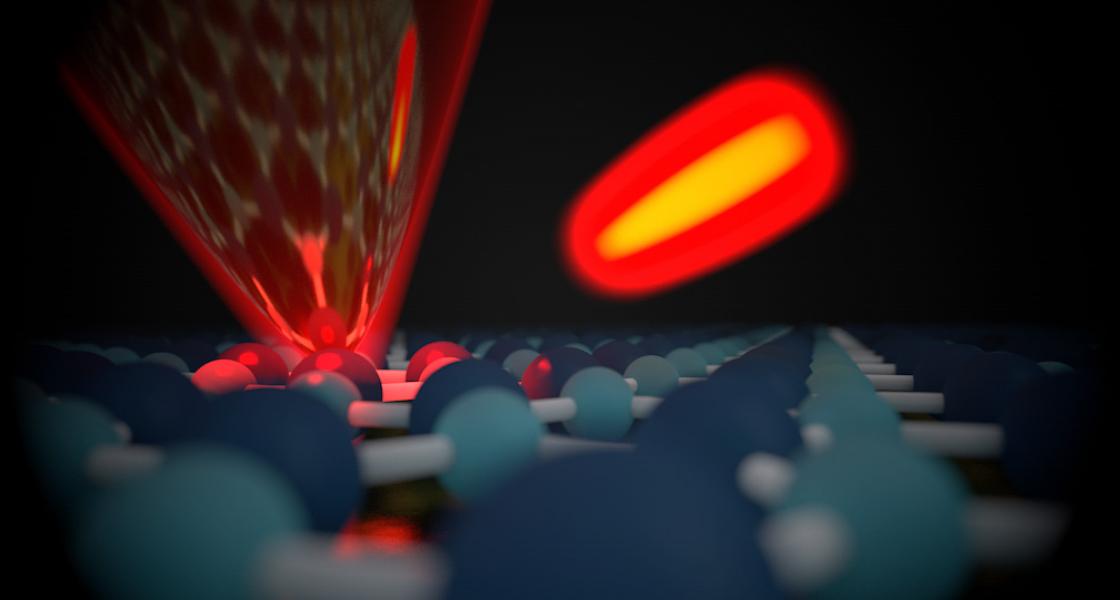Researchers from the Raschke group are lighting up dark excitons.
Specifically, the Raschke group developed a method to observe dark excitons in a 2D (i.e., a single layer of atoms) semiconductor at room temperature. This observation is an exciting development in the story of dark exciton applications, which includes quantum information processing and fundamental studies of complex semiconductor materials.
Bright excitons – which very rapidly emit light after forming – have long been used to probe materials and fundamental quantum processes. Now the Raschke group is seeking to make use of normally invisible dark excitons as well.
Dark excitons are bound electron-hole pairs that, unlike their bright exciton counterparts, face spin-forbidden transitions that prevent recombination through photon emission. Because these excitons are reluctant to emit a photon, they remain dark.
Darkness means stability: a dark exciton’s “photoluminescence lifetime and coherence time is a thousand times longer than that of a bright exciton,” says Kyoung-Duck Park, the lead graduate student on this project. These long lifetimes are what make dark excitons potential candidates for quantum computing: the state, once manipulated, can hold onto information for a long time.
But emission reluctance, or darkness, is both an advantage and a weakness.
“The problem is, how do you read it out if it is not emitting?” says JILA Adjunct Fellow, and the principal investigator, Markus Raschke.
While dark excitons are good at holding information, they also need to release information on command in order to be useful in computing, or other opto-electronic, applications.
Previous attempts to induce dark exciton emission required both strong magnetic fields and cryogenic temperatures. But “it is really difficult to imagine devices for practical application if they require low temperature and extremely high magnetic field condition,” says Park.
Park instead uses only a very sharp, gold tip to coax the dark excitons into emission.
“It’s more of a piece of wire that tapers very sharp, and it’s out of gold or silver, because we want very high optical conductivity,” says Raschke.
Park’s technique requires no magnetic fields and works at room temperature, yet sees a 600,000 times enhancement in the emission of dark excitons over previous methods.
The gold tip, carefully placed only nanometers away from the dark exciton, can then broadcast the dark exciton’s signal. Much like how a radio antenna converts electrical signals into radio waves, the gold tip acts as an optical antenna that converts the exciton’s electrical information into optical waves, or photons.
And Park’s technique can not only brightens dark excitons, but switch the brightness on and off. The distance between the tip and exciton acts as a nano-optical cavity. This distance determines whether the tip is coupled to the exciton, i.e., whether the tip can broadcast the exciton’s signal. Therefore, by fine adjustment of this distance, a dark exciton’s emission can be switched on and off, much like how a light switch can brighten or darken a room with the flick of a finger.
This research was published recently in Nature Nanotechnology.The experiment was conceived and led by University of Colorado Boulder graduate student Kyoung-Duck Park and JILA Adjunct Fellow Markus Raschke, with the aid of postdoctoral associate Tao Jiang. The samples were prepared by Genevieve Clark and Xiaodong Xu from the University of Washington.
Written by Catherine Klauss



 The Physics Frontiers Centers (PFC) program supports university-based centers and institutes where the collective efforts of a larger group of individuals can enable transformational advances in the most promising research areas. The program is designed to foster major breakthroughs at the intellectual frontiers of physics by providing needed resources such as combinations of talents, skills, disciplines, and/or specialized infrastructure, not usually available to individual investigators or small groups, in an environment in which the collective efforts of the larger group can be shown to be seminal to promoting significant progress in the science and the education of students. PFCs also include creative, substantive activities aimed at enhancing education, broadening participation of traditionally underrepresented groups, and outreach to the scientific community and general public.
The Physics Frontiers Centers (PFC) program supports university-based centers and institutes where the collective efforts of a larger group of individuals can enable transformational advances in the most promising research areas. The program is designed to foster major breakthroughs at the intellectual frontiers of physics by providing needed resources such as combinations of talents, skills, disciplines, and/or specialized infrastructure, not usually available to individual investigators or small groups, in an environment in which the collective efforts of the larger group can be shown to be seminal to promoting significant progress in the science and the education of students. PFCs also include creative, substantive activities aimed at enhancing education, broadening participation of traditionally underrepresented groups, and outreach to the scientific community and general public.